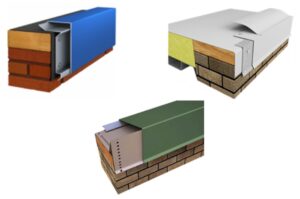What is Green Roofing?
Green roofing, also known as a vegetative or eco-roof, consists of a layer of vegetation that is planted over a waterproofing system. These systems are typically installed on top of a flat or sloped roof.
There are three main categories of green roofs: extensive, intensive, and semi-intensive. Extensive green roofs are typically shallow and lightweight; they are popular among homeowners as they require minimal maintenance.
On the other hand, intensive green roofs require much more maintenance as they are typically found in larger, commercial projects, and need deeper layers to support thicker vegetation.
Lastly, semi-intensive green roofs are a mix between extensive and intensive. They can support a greater assortment of plants, but not large shrubs or trees.

Types of Green Roofing
Extensive Green Roofing
As stated above, an extensive green roof is typically shallow and lightweight; they are popular among homeowners as they require minimal maintenance. Extensive green roofs require plants that have a low growth height, rapid growth, and roots with a high drought tolerance; plants such as succulents and grasses are ideal.
Succulents are plants that make use of crassulacean acid metabolism (CAM). This allows the succulent to photosynthesize during the day while only exchanging gases at night, allowing for minimal water loss, thus providing stormwater management. Although grasses don’t use CAM photosynthesis, they are often used in extensive green roofing for their aesthetic appearance. Grasses require more watering, maintenance, and irrigation.

Intensive and Semi-Intensive Green Roofing
Intensive green roofs require a lot of maintenance as they are typically found in larger, commercial projects, and need deeper layers to support thicker vegetation. Semi-intensive green roofs are a mix between extensive and intensive; they can support a greater assortment of plants, depending on the root systems. When it comes to an intensive green roof, think of a garden or park.
Due to its growing medium thickness, intensive green roofs can hold a wide variety of plants such as large trees, shrubs, and native vegetation. On the other hand, a semi-intensive growing medium is not as thick, therefore it can only hold smaller root systems. Due to added weight and maintenance, one thing to consider when looking into intensive and semi-intensive green roofs is the structure of the building.


Layers of a Green Roof
Green roofing consist of distinct layers; the structure of a green roof is as follows: vegetation, growing medium, filter membrane, drainage layer, waterproof/root repellant, roofing membrane system, thermal insulation, vapor control, and structural roof support. Each of these layers are crucial to ensure that the vegetation stays alive as well as protect the structure beneath.
Unlike traditional soil used for gardens or house plants, growing medium is not the same. Growing medium consists of material aggregates (i.e. gravel, crushed stone, sand, etc.) and a small amount of organic material; this allows for better drainage and aeration. It should be lightweight and resistant to decomposition.


Benefits of a Green Roof
Economic Benefits
Green roofs can often be costly upfront, however, they tend to save money in the long run. They reduce energy consumption because they cool roofs as well as provide shading, thermal mass and insulation. Also, in areas where there is little green space, green roofing can increase the property value and salability. “GSA [U.S. General Services Administration] found that building owners can achieve lifetime cost savings of about $4.15 per square foot by installing a planted roof instead of a conventional roof” (Source: The Benefits and Challenges of Green Roofs on Public and Commercial).
Stormwater Management
When it rains, storm water typically runs off of a roof into the gutters and proceeds into a storm sewer, along with all of the contaminants from the roof and ground. Depending on the area, water then goes into a water treatment facility or the ecosystem (i.e. lakes, streams, and rivers). However, green roofs soak up the storm water, retaining it in the plants and growing medium; this reduces the amount of stormwater entering the ecosystem, thus reducing flooding and erosion.

Longer Roof Life
The lifespan of a commercial roof depends on the type, but the average is roughly thirty years. Surprisingly, a green roof lasts anywhere from forty to fifty years. By having a green roof, the roofing materials are protected from UV radiation and extreme temperatures. Because of this, there is less maintenance and replacement costs as long as the green roof is well taken care of. To learn more about the lifespan of a typical commercial roof, visit our blog: How Long Does a Commercial Roof Last?
Summary
Overall, green roofing is a great option when it comes to energy efficiency and saving money. In places where there is little green space, green roofs increase property value and salability. The lifespan of a green roof is often longer than that of a typical commercial roof. Although it is costly upfront, green roofing saves money in the long run. Not to mention, their aesthetic appeal is unmatched. When looking into a green roof, it is important to ensure that your building is structurally sound enough to withstand the weight


